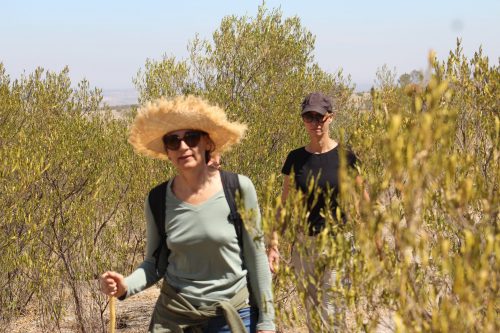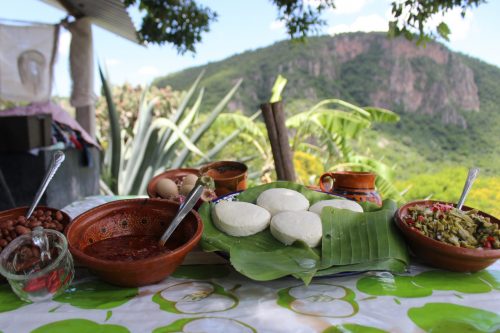There was a time when oaks dominated the mountains of Guanajuato State. However, it was a mining area, and the residents needed fuel. Deforestation led to some areas becoming barren, or “bald.” This assertion from San Miguel’s Francisco Peyret, Director of Environment and Ecology, is supported by data from a decades-long study by the Autonomous University of Querétaro. Based on the studies, Director Peyret is focusing on a reforestation project with the help of civil organizations. The intent is to increase the existing 80 reforested hectares to more than 1,500 hectares. In all the communities where people are willing to participate will be planted with maguey and other native flora such as agave and ocotillo, and mesquite, olive, sweet acacia, and oak trees. All the planting will take place prior to the beginning of the rainy season (May) and will generate temporary employment for 300 local people in the ejidos (communal land). The pay is 1,250-1,500 pesos per week.
In addition to this temporary employment for ejidatarios (members of the ejidos), the Ecology director envisions another positive result. Why not develop “soft tourism” at the same time? It would attract people who appreciate nature and will provide a boost to the local economy.

A first-hand look at the area
At present there is limited, unofficial tourism. No one knows how or when the Los Toriles ejido was founded. Currently, the Monzón, Mosqueda, and Hernández families live there and form the small nucleus of residences that dot the area. Even the residents don’t know how they ended up living “up here.” We visited the area with a pilot tour group and Héctor Mosqueda, a 27-year-old resident of the ejido spoke to us as we walked along the route with him, Luis and Don Tomás. If you do not have an appointment with a guide and are looking for Los Toriles, you must find the entrance to San Lucas along the highway to Guanajuato. When you stop at the first store on the road and ask the owner, “How long does it take to get to Los Toriles?” he will first look to see the type of vehicle you are driving. After that he’ll make his calculation. He told us.
“With that truck, you’ll arrive in an hour. Go straight, cross the bridge, and keep going until you get there.” You will have to negotiate rocky sections and flat areas, and travel uphill and downhill until you reach the top. On the way, you will notice the change in vegetation from sweet acacia and mesquite to oak. Once you see those trees, you know you are nearing Los Toriles. You might think there is nothing there, but then you see that the land is tilled and cultivation abounds.
There are some small man-made bodies of water, and numerous burros, mules, and horses can be observed in the distance. These are scenes worthy of a video of old San Miguel, one that ended long ago.
Today the residents are trying to put Los Toriles back on the map, and along with that foster soft tourism to help improve the economy. According to Mosqueda, those who live there are happy with what they have. He is aware of the natural beauty of the ejido. There are caves by the stream that have faint traces of cave paintings. There are wells where water is collected every morning and mules carries it uphill, where it is stored and kept fresh. Mosqueda told us that the mules were purposely bred because their strength is unique.
We enjoyed the beauty of the area first hand during the walk as our guide described what we were seeing. He explained, “We work the land. From one hectare we can harvest up to one ton of corn (for atole, tortillas, tamales). Beans? We buy them,” Mosqueda told us. A singular scene captured our attention. In the midst of this dry land was a tree, under which some cows were taking shelter from the sun. In the distance we saw La Mesa del Gato, a hill from which views of the sunsets are magnificent. You can also see the frames of the small houses built along the steep incline.
If you pay attention along the walk, you notice that the tepetate—volcanic, dry, compacted land—changes from brown to yellow. It turns green where the cactus-like ocotillo (thorny scarlet-flowered candlewood) grows. According to Francisco Peyret, this is one of the most important plants in the restoration and preservation of the soil; in addition to its ability to help water absorption (preventing water runoff), it is extremely drought-resistant. Soon after finding ocotillos, you see oaks and a dreamy canyon whose crystal-clear water is potable.
Continuing on you go uphill and downhill. If you are lucky, you might see an armadillo or a deer. At the end of the Toriles nature tour, visitors can have a meal and eat like the residents, in a local house. The red rice, beans cooked in a pot, goat cheese, pork rinds in red sauce, and nopalitos are prepared by Sra Concepción Hernández and her daughters. If you stay until late afternoon, you can enjoy watching as the horses, mules, and burros are herded towards the corral, because “that’s how country life is.”

La Joyita, Doña Juana, and Pinallillo
In some areas, the reforestation route already has signage in ejidos in conjunction with the office of State Tourism. One of these is Doña Juana. There, the ejidatarios have already worked with the organization El Maíz Más Pequeno to build gabions and filtering dams. Subsequently, the municipality and the state delivered saplings for reforestation, and material for fencing. Today the area is cared for and protected by the residents, and is open for group visits.
Between El Pinalillo, on the northeast side, and El Pedregudo, is La Joyita, a unique space with red mountains, oak, maguey, and other native plants. Here, Alex, Juanita, and their son Fernando live. The tourism route already exists, and the guide is Fernando, a boy only 11 years old, who was born in the mountains and knows the area like the back of his hand.
Francisco Peyret was emphatic when he told us that the tourism project to be consolidated is contemplative it has not been formalized; the tours are be for those who love and enjoy nature, and who want to directly benefit the communities. To take any of the tours, contact Julio Bernal, Ecologia associate, on 555 452 7914.

